
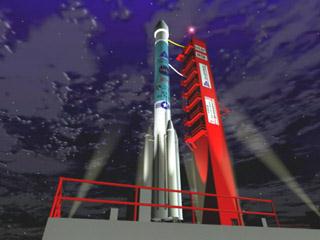
The Boeing Delta II 7425 launch vehicle consists of three stages stacked on top of each other, plus 4 small solid-fuel rockets strapped to the outside of the first stage. Each of the four solid rocket motors is 1 meter (3.28 feet) in diameter and 13 meters (42.6 feet) long; each contains 11,765 kilograms (25,937 pounds) of hydroxyl-terminated polybutadiene (HTPB) propellant and provides an average thrust of 446,023 newtons (100,270 pounds) at sea level. The casings on the solid rocket motors are made of lightweight graphite epoxy.
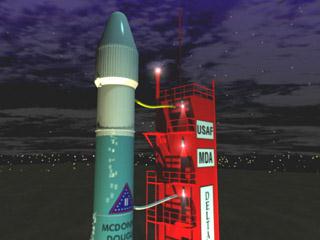
At the very top of this "stack" is the spacecraft, inside a protective metal shell. Mars Polar Lander's main structure, or bus, is 1.06 meters (3.5 feet) tall by 3.6 meters (12 feet) wide. At launch it will weigh 576 kilograms (1,270 pounds), including the 290-kilogram (639-pound) dry spacecraft plus 64 kilograms (141 pounds) of fuel.
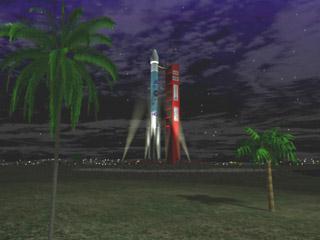
Liftoff will take place from Space Launch Complex 17 at Cape Canaveral Air Station, Florida. Each stage has its own rocket motor. The first two stages use liquid rocket fuel. The third stage uses solid rocket fuel.
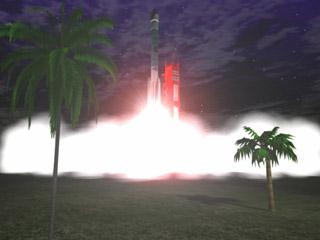
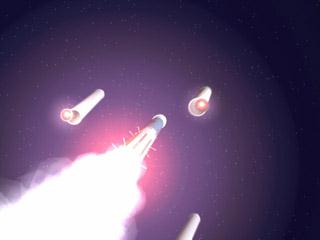
Sixty-six seconds after liftoff the 4 solid rocket "strap-ons" are discarded and fall into the ocean. Two of the four solid rocket strap-ons will be discarded first, and the remaining strap-on boosters will be jettisoned one second later, while the first stage continues to burn. At this point, the launch vehicle will be at an altitude of 21.7 km (13.4 miles) and traveling at a velocity of 3,899 km/hour (2,423 miles/hour).
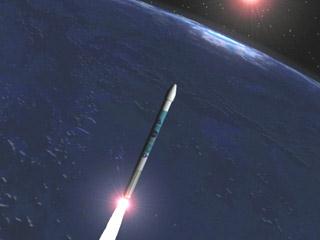
The central first stage continues to burn for over 3 minutes. The main body of the first stage is 2.4 meters (8 feet) in diameter and 26.1 meters (85.6 feet) long. It is powered by an RS-27A engine, which uses 96,160 kilograms (212,000 pounds) of RP-1 (rocket propellant 1, a highly refined kerosene) and liquid oxygen as its fuel and oxidizer.
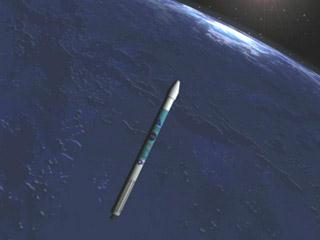
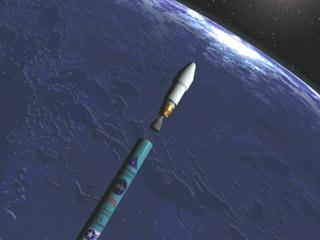
4.4 minutes after liftoff the first stage shuts itself off (main engine cutoff) and is discarded (first stage separation). The spacecraft is now at an altitude of 122 km (76 miles) and traveling at a velocity of 19,404 km/hour (12,057 miles/hour). One stage down, two more to go!
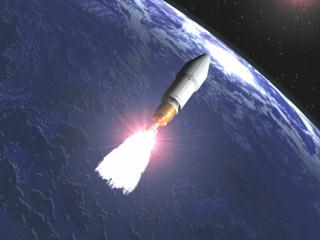
13.5 seconds following main engine cutoff, the second stage is fired. The second stage is 2.4 meters (8 feet) in diameter and 6 meters (19.7 feet) long, and is powered by an AJ10-118K engine. The propellant is 5,900 kilograms (13,000 pounds) of Aerozine 50 (A-50), a mixture of hydrazine and unsymmetrical dimethyl hydrazine (UDMH), and nitrogen tetroxide as the oxidizer. This engine is restartable, and will perform two separate burns during the launch.

The metal shell (fairings) covering the spacecraft is discarded 4.5 seconds after second stage ignition.

The second-stage burn ends about 11 minutes, 22 seconds after liftoff. At this point, the vehicle will be in a low-Earth orbit at an altitude of 191 kilometers (119 miles). Depending on the actual launch date and time, the vehicle will then coast for 23 to 26 minutes. Once the vehicle is at the correct point in its orbit, the second stage will be restarted for a brief second burn.
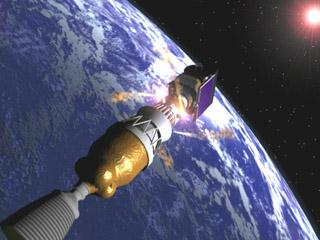
Before the third stage's rocket is fired to get the spacecraft out of Earth orbit and on its way to Mars, it has to be "spun up" first. Small rockets are used to make the third stage spin about its long axis. Actually, the third stage will spin on turntable attached to the second stage.
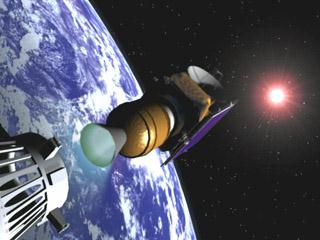

The third and final stage of the Delta 7425 is a Thiokol Star 48B booster, the same final stage used in the 1996 launch of Mars Global Surveyor. The Star 48B measures 2.12 meters (84 inches) long and 1.2 meters (4 feet) wide. Its motor carries solid propellant composed of a mixture of aluminum, ammonium perchlorate and hydroxyl-terminated polybutadiene (HTPB) solid propellant. The spinning third stage separates from the second stage, and the the third stage motor ignites, sending the vehicle out of earth orbit. The reason we want the vehicle to spin during this burn is so it stays pointed where we need it to point. Spinning it stabilizes it, like a spinning bullet fired from a rifle. A nutation control system (a thruster on an arm mounted on the side of the third stage) will be used to maintain stability during this 88-second burn.
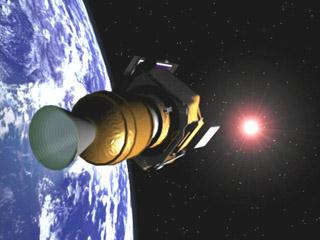
Now, the third stage, with its solid rocket fuel exhausted, and with the spacecraft attached, are on their way to Mars. However, the spinning upper stage and the attached Mars Polar Lander must now be despun so that the spacecraft can be separated and acquire its proper cruise orientation.
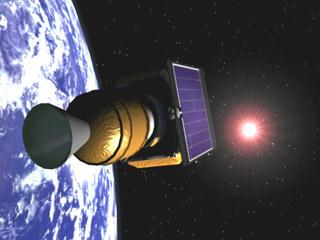
Despinning is accomplished by reeling out weights on the end of tethers (like yo-yos) attached to the third stage. This slows the rocket's spin, the same way a spinning ice skater slows if she extends her arms away from her body.
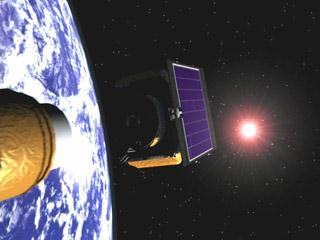
Approximately 45 to 49 minutes after liftoff, Mars Polar Lander will separate from the Delta's third stage. Any remaining spin will be removed using the spacecraft's onboard thrusters.
At the time of launch, the lander is encased within an aeroshell attached to a round platform called the cruise stage. Because the lander's solar panels are folded up within the aeroshell, a second set of solar panels is located on the cruise stage to power the spacecraft during its interplanetary cruise. About 50 to 55 minutes into flight, these hinged solar panels will unfold; the spacecraft will fire its thrusters to orient the solar panels toward the Sun. Around that time or shortly thereafter, the 34-meter-diameter (112-foot) antenna at the Deep Space Network complex in Canberra, Australia, will acquire Mars Polar Lander's signal.
| Home | Mars Polar Lander | Deep Space 2 Microprobes | Mars Climate Orbiter |
| Welcome | Mailing List | Links | Credits |
For questions or comments on this website please refer to our list of contacts.